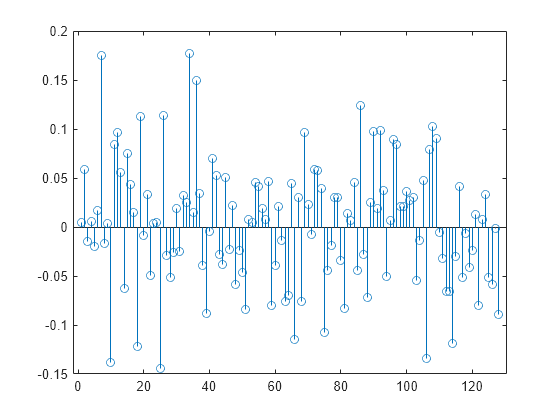OFDM de base sans préfixe cyclique
L’OFDM émet simultanément des signaux de sous-porteuses composés de sinusoïdes superposées, orthogonaux et étroitement espacés. Les données d'émission sont d’abord codées et modulées, généralement en symboles QAM. Ces symboles sont chargés dans des segments de fréquences équitablement espacées, puis une IFFT (Inverse Fast Fourier Transform) est appliqué pour transformer le signal en sinusoïdes orthogonales superposées (sous-porteuses) dans le domaine temporel. Puisque les sous-porteuses individuelles sont en bande étroite et connaissent des évanouissements uniformes, l’égalisation du côté récepteur ne requiert qu'une prise par sous-porteuse.
Créez un système OFDM simple, en utilisant le signal 16QAM à porteuse unique comme entrée du modulateur OFDM. Un diagramme à tiges montre que tous les segments de fréquences contiennent des données.
bps = 4; % Bits per symbol M = 2^bps; % 16QAM nFFT = 128; % Number of FFT bins txsymbols = randi([0 M-1],nFFT,1); txgrid = qammod(txsymbols,M,UnitAveragePower=true); txout = ifft(txgrid,nFFT); stem(1:nFFT,real(txout))

Filtrez les données d’émission sur un canal AWGN avec un bruit minimal. La réception OFDM inverse le traitement d’émission. Appliquez une démodulation FFT et QAM, puis confirmez que les symboles reçus correspondent aux symboles émis.
rxin = awgn(txout,40); rxgrid = fft(rxin,nFFT); rxsymbols = qamdemod(rxgrid,M,UnitAveragePower=true); if isequal(txsymbols,rxsymbols) disp("Recovered symbols match the transmitted symbols.") else disp("Recovered symbols do not match transmitted symbols.") end
Recovered symbols match the transmitted symbols.
Tous les segments de fréquences de l’IFFT sont remplis de données pour cette émission. Dans les systèmes pratiques, les extrémités des segments de fréquences sont souvent laissés vides afin de servir de bandes de garde, et certains segments peuvent être utilisés pour envoyer des signaux de pilotes spécifiques. L’association de bande de garde et de signaux pilotes aide à la synchronisation et à l’égalisation.